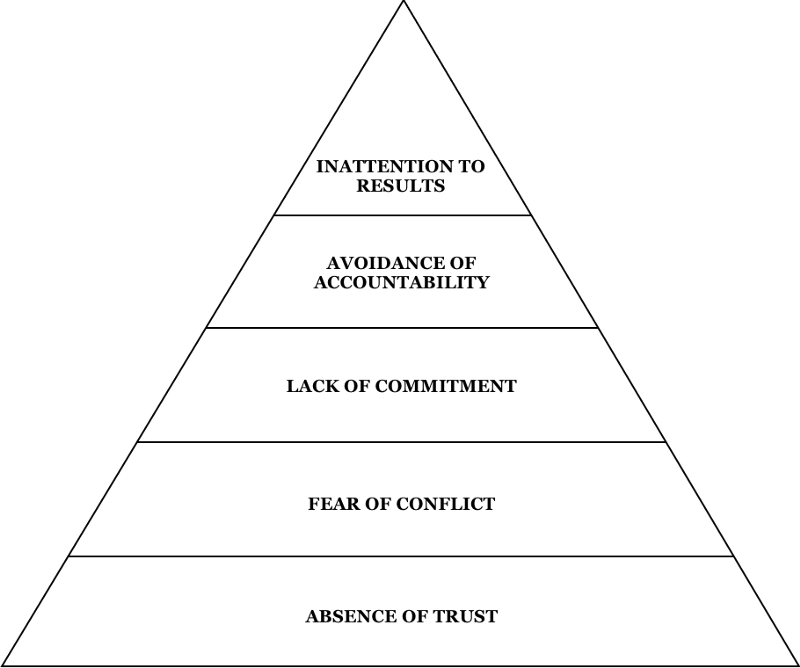Acme was going to revolutionize the renewable energy industry with their new type of solar panels and create a sustainable world. John, a 27-year-old account executive, was going to do everything he could to help Acme make this a reality. He always cared deeply about the environment, so after graduating it only made sense for him that his first job would be at Acme. Even though other companies offered John higher paychecks, he still chose Acme because he believed in what they stood for. John had a lot of fun at his new employer, he was extremely enthusiastic about his career, and he was a joy to work with. John was known for his famous jokes bringing a lot of laughter, and comfort to the people around him. So it was no surprise that both colleagues and clients liked to work with him. John worked hard for his organization, putting in long hours not because he had to but because he loved what he was doing, and he was making an impact. He felt he had a purpose.
Before we continue on how things are at Acme, let’s go back a few months before John graduated. During that time he had a few jobs. He also did a lot of volunteering like helping with cleaning up plastic at local beaches, but he also worked at the local grocery store a few evenings each week.
John’s manager at the local grocery store, Jannet, would give him a list of tasks each evening and then quickly disappear into the back office. The list of tasks always looked rushed, the handwriting was often difficult to read, and it would only contain a handful of short instructions assuming John would figure out what to do on his own. John did his best to complete all the tasks, but sometimes he had no idea what to do and to make matters worse, John found it difficult to ask for help, afraid of what people would think of him.
John’s friends and family noticed that John was struggling with his job at the grocery store as he often complained about how things were going. They did the best they could by giving him advice about how to handle the situation. Eventually, John took their advice and gathered the courage to go and ask Jannet for help.
On the day he was going to ask Jannet for help, he was extremely nervous thinking about what could happen. Once the moment was there, he could barely speak, but he managed to complete the sentence. “Would you maybe, ehm, be able to explain, ehm, how I would do the fourth task on the list?”. Jannet responded, looking down skeptical at John as if it was really that difficult to understand the tasks she gave to him. She said she had more important things to do and quickly gave some confusing instructions which didn’t help. Afraid of confronting Jannet about the fact that her instructions didn’t help he accepted her answer and went back to work.
Every week Jannet would, however, complain and become somewhat angry about the fact that John did not complete all his tasks. Since John’s last attempt to ask for help, he had become even more afraid to try it again and would just accept the negative feedback and continue. Luckily for him, there was a light at the end of the tunnel. He was about to graduate in a few weeks and start at Acme.
John, of course, also had a manager at Acme, and his name was Alex. Even though John enjoyed his work, he didn’t like Alex that much. Alex would often only show up to complain when things didn’t go according to plan just like Jannet. Alex would also never give recognition to his colleagues; he believed everyone is paid to perform, so it only made sense that your salary is your reward for doing well. Alex was also known as the king of negative reinforcement, focussing on people’s weaknesses rather than their strengths. Luckily for John, he had some great colleagues, and they would give each other moral support after Alex finished yelling. Funny enough all his colleagues thought the same about Alex, but no one felt safe enough to confront him about his behavior.
Let’s fast forward one and a half years.
Acme was changing and not for the better. Even though they were expanding to multiple countries, hiring many new people, and successfully disrupting the market with their solar panels, the profit motive was getting unmoored from the purpose motive. The purpose of creating a sustainable world was lost out of sight.
So even though Acme was quite successful, John was experiencing something strange. He had more difficulty getting out of bed each morning, and at work, his mind would often drift off. His energy level was lower than usual, and there was this weird vibe going around the office, he felt somewhat detached, but he couldn’t figure out what was causing it.
Meanwhile, Alex was putting more and more pressure on his team to reach unrealistic quarterly targets he defined without even discussing these with the team. To get there, they had to take on many more accounts while they already had their hands full with the current account base. Just like Jannet, Alex would quickly disappear after commanding everyone on what to do. Just like when John was working at the grocery store. John and his colleagues did know what they needed to do, but they didn’t know how to. They never had to handle so many accounts, and no one was teaching them how they could pull this off. All of them knew they were having the same issues but rather than asking each other for the help they needed, they started to point fingers and blame each other for the fact they weren’t able to keep up.
To make matters worse, one of John’s best friends got very ill. During the next couple of weeks, John went out of his way to support his friend in any way he could. He would visit him before work, after work and during the weekends. The stress at home and work was starting to take a toll. He was sleeping less every week, and his performance at work was at an all-time low.
On a Monday afternoon, John came across Alex in the hallway, and Alex said to John, “It’s the fourth week in a row that you haven’t reached your target. If you continue like this, I don’t think you have a future here”. With everything that was happening, John felt like the rug was being pulled out from under him. It was like the whole world started to crumble around him and no one was there to help him out. John had hit rock bottom.
I’ll leave the rest of the story to your imagination. However, if you want to know how Alex should have responded and why his team is not functioning well? Be sure to continue reading.
-------
First, let me explain what the moral of the story is and how I came about writing it.
A good friend of mine shared a link with me a few days ago, and it was a YouTube video with an interesting interview with Gary Vaynerchuk. Gary said something which spoke out to me. He defines two types of leaders. Namely, HR-driven leaders and CFO-driven leaders. Meaning you care either about people or money. The latter is the most common. It would be fine if we would still be in the 20th century, but since we are not, let me explain why I believe the 21st-century workforce needs HR-driven leaders.
In 2016 generation Y or better known as the millennials (born between 1980 and 1996), became the largest generation in the workforce, and it’s expected to be 50% of the total workforce in two years. In 2030 it will be 75% according to the U.S. Bureau of Labor Statistics.
Millennials have very different traits compared to their predecessors like the baby boomers generation. Given these facts, it’s no surprise there is a lot of research on how this generation behaves. Gallup did a fantastic job at gathering insights in their “How Millennials Want to Work and Live” analysis. I’m guessing you don’t have time to read all 150 pages right now so let me point out some interesting facts:
So it’s clear something is happening, and it’s something which never happened on a scale like this before. Back in the 20th-century people would marry and get children in their early twenties, so their purpose was to provide for their family. They would then simply accept a job, and do their thing for years without any complaints because in return they would receive a paycheck and some benefits. If their boss asked them to jump, they would jump because they were paid to do so. For this reason many felt unattached to their job, leaving at 5 p.m. without much afterthought.
These days are over, in the 21st-century people like John care about more than just a paycheck — they want a sense of purpose. They desire to work for organizations with a purpose, a mission, and those who give particular importance to their development and not their satisfaction (meaning they don’t care about ping pong tables, fancy coffee, and free food). They don’t want bosses — they want coaches. They don’t want yearly performance reviews focused on what they have been doing wrong. They care about having managers who can coach them by having ongoing conversations, who value them as people and employees, and who help them understand and build their strengths. They also see work and life tightly integrated. Technology is one of the reasons, as everyone is always (expected to be) “on” these days. People can work remotely and not just from home, but from anywhere in the world. Technology is changing the way how we interact, communicate, and collaborate.

Knowing who millennials are as people matters (or any generation for that matter). Organizations that fail to understand the value of the millennial mindset will fail to create work environments that attract and retain them. In fact, the research by Gallup also points out both many leaders and managers recognize the importance of understanding millennials given the fact baby boomers are retiring from key positions and these positions need to be filled. This is a problem as they have no idea how to connect with this group. Many leaders try to understand the millennial workforce, but in the absence of concrete answers, solutions, and intrinsic motivation to learn this generation, many of them seem to stick with existing policies, which in turn causes many millennials to feel misunderstood as these existing policies were made for previous generations. The fact that millennials feel misunderstood is one of the reasons 55 percent are not engaged. Which I find unfortunate because I see organizations fire people with great potential because “they don’t have what it takes.” Only to see a lot of these people find new jobs elsewhere and become successful. I adamantly believe organizations with a high turnover of staff should take a good look at themselves rather than blaming the employee.
Purpose and development drive the millennial generation.
For those who think replacing people is more manageable and cheaper, think again. According to EBN, it costs employers 33% of an employee’s annual salary to hire a replacement if someone leaves not to mention indirect costs like knowledge loss, the time spent finding a replacement, and the time new hires need to become fully functional.

Given these findings, there is no denying that leaders need to change if they want their organizations to succeed and thrive. I believe that those who choose to keep leading numbers instead of people will have increasing difficulties coming years while more and more millennials join the workforce. As leaders used to be hired and fired by their bosses, but these days, however, you can simply be rejected by the people you lead. So for those who are interested in some pointers towards becoming an HR-driven leader, be sure to check the following five tips.
First, you should strive to connect with your employees every day. Treat these ongoing conversations as coaching conversations, providing your employees with an opportunity to tell you (their coach) what they need or what’s on their mind and to receive immediate feedback.
One important thing to do when you start having these conversations is to really listen instead of waiting for the other person to finish so you can tell your story. If you need help with this, I can recommend a great book called Just Listen — by Mark Goulston in which he explains how to listen effectively. As it turns out, most of us hear what others are saying, but they don’t really listen.
It would be best if you are more interested in listening to others than you impress them. I enjoy listening and observing others, but for those who are new to this, Mark Goulston provides a great tip to master the skill of being sincere and interested when listening. First, stop thinking of conversations as a tennis match. Instead think of it as a detective game, in which your goal is to learn as much about the other person as you can. Go into the conversation, knowing that there is something very interesting about the person, and be determined to discover it.

Purpose, mission, and values (PMV) give your employees both direction and a meaningful way of working on getting there. They help them with long-term decision-making and align everyone with a clear common goal. If you don’t have a PMV right now, I recommend you get started on defining these first thing tomorrow.
Don’t think you can check this off your list by simply putting these on the wall. You and your entire organization for that matter have to live and breathe the purpose, mission, and values for this to work. You can’t keep your employees accountable for any of these if you don’t hold yourself accountable. Also, don’t let profit get in the way of your organization's PMV unless you want bad things to start happening.
“When the profit motive gets unmoored from the purpose motive, bad things start to happen. Product and service quality often drops, employees are unhappy, and these places become uninspiring to work for”

Build it — The Rebel Playbook by Glenn Elliot & Debra Corey is a must-read for anyone who wants to lead an organization with engaged employees. Research shows that recognition is a huge part of having engaged employees. So here is the strange thing. More than one-third (34%) of senior decision-makers don’t think that regular recognition and thanking employees at work has a significant impact on staff retention. They couldn’t be more wrong.
70% of employees say that motivation and morale would improve if managers said thank you more. That’s two in every three of your employees who would be more productive if they were recognized.
— Reward Gateway Employee Recognition Survey 2017
Since we’re talking about leading people and not numbers the following shouldn’t be a surprise. It’s never, ever, ever all about the money. Giving monetary rewards can have a negative impact on your employees (see the video in the next section). In some cases, it can be motivational, but it’s the message that employees value more than anything else. Show your employees you see them as real human beings and not just an employee. Writing a personal postcard, for example, shows that you’re thinking about them as a person, adding value and meaning to their life. A personal message means so much more than a €25 gift card. To give you an example; I worked remotely for about seven years for a company called Envato, and each year, I would receive a personal handwritten card from the CEO and a small gift. Even though I was 15.000 kilometers away from their headquarters, they thought of me, and it made me feel appreciated and connected to the organization. I even still have all the cards.
https://www.youtube.com/watch?v=u6XAPnuFjJc
The video is an animation based on Drive — by Daniel Pink in which he explains the surprising truth about what motivates us. Be sure to check it out.
To answer your first question. Yes, money is a motivator, that’s a fact. If your employees have difficulties making ends meet they won’t be motivated and they will be distracted. That leaves three crucial factors, which will lead to better performance and personal satisfaction.
If one or more of these three factors are not present within your organization, people will start leaving, and for those who stay, some will find their paycheck increasingly more important in order to compensate for the fact they are not enjoying their time at work. This is interesting as 71% of professionals said they’d actually be willing to take a pay cut to work for an organization with a purpose they believe in and shared values according to LinkedIn. The purpose and values of Acme are the reason why John choose to work for Acme; they shared the same beliefs.

Patrick Lencioni is the author of the book called The Five Dysfunctions of a Team and it has become the world’s most definitive source of practical information for building teams. Make sure you read this book. I promise you; you will be glad you did.
Lencioni writes about teams and looks at things from a negative perspective (the dysfunctions) teaching you how to improve your team once things are going bad. So if we look at this from a leadership perspective, you want to lead in such a way that you built teams that are healthy from the start and stay healthy without any dysfunctions.
If you take a look at the pyramid above, you will start to understand why John and his colleagues weren’t confronting Alex, why they were starting to point fingers and why things were deteriorating in general. Alex did not develop any trust because he created an unsafe environment. The lack of trust is the reason why there is a massive fear of conflict and why they choose to preserve artificial harmony. Without conflicts, you get a lack of commitment. Without commitment, you get a lack of accountability. Last but not least, without accountability, you don’t get results.
Absence of Trust
The fear of being vulnerable to team members prevents the building of trust within the team.
The book contains a questionnaire you can use to figure out which of the five dysfunctions requires attention in your team. It also has some cool exercises you can do with your team to improve any dysfunctions your team might have.
The five leadership principles
This article probably wouldn’t even exist if I hadn’t graduated as a Professional Business Communicator earlier this year at the Business NLP academy. This education has been a life-changing experience for me as I learned so much about myself, what it takes to be a leader, how people work, the importance of verbal and nonverbal communication, but it also helped me discover a new passion; helping others to get the most out of themselves. The reason I’m telling you this is because this is where I also learned the five leadership principles of a Professional Business Communicator which are based on Lencioni’s work.
----
To wrap up things, I want to talk about John and Alex. Alex said to John, “It’s the fourth week in a row that you haven’t reached your target. If you continue like this, I don’t think you have a future here”. Alex does not observe; he doesn’t listen; he is not sincere nor interested in others. He assumes things about John rather than talking with him. How do you think John would have responded if Alex said something along the lines of:
“It’s the fourth week in a row that you haven’t reached your target. Are you alright? Can I help?”
This is how I believe a leader behaves. So the next time you start making assumptions about someone’s performance, please think twice and have a friendly conversation to figure out how someone is doing rather than assuming the worst.
Find out if MentorCruise is a good fit for you – fast, free, and no pressure.
Tell us about your goals
See how mentorship compares to other options
Preview your first month
